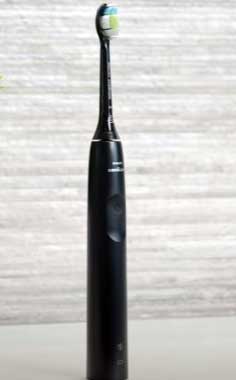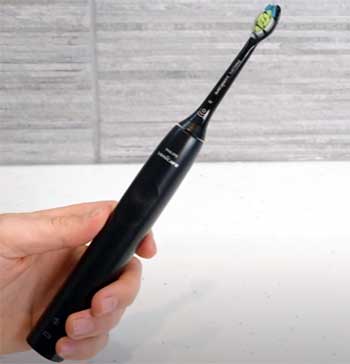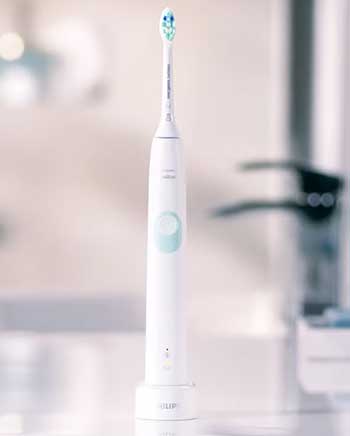As someone who’s always been particular about my dental routine, I decided to explore the Philips Sonicare 1100 and 4100 electric toothbrushes to see which one suits my needs—and maybe yours too.
Both models promise cleaner teeth and healthier gums, but they differ in features, performance, and price. In this article, I’ll share my experience using both, breaking down their pros and cons, and help you decide which toothbrush is the best fit for your daily routine.
Let’s explore what makes these brushes tick and whether the 4100’s upgrades justify its higher cost.
A Brief Comparison Table
| Feature | Sonicare 1100 | Sonicare 4100 |
| Price | ~$20-30 | ~$40-50 |
| Brush Strokes per Minute | 31,000 | 31,000 (tuned for higher amplitude) |
| Cleaning Modes | 1 (Standard) | 2 (High, Low) |
| Brush Head | C1 SimplyClean | C2 Optimal Plaque Control |
| Pressure Sensor | No | Yes (vibrates to alert) |
| BrushSync Technology | No | Yes (tracks brush head usage) |
| Timer & QuadPacer | Yes (2-min timer, 30-sec pacer) | Yes (2-min timer, 30-sec pacer) |
| Battery Life | Up to 14 days | Up to 14 days (17-41 days tested) |
| Intensity Settings | 1 | 2 (High, Low) |
| Design | Chunkier handle, matte finish | Slimmer handle, sleek design |
| Charging | USB charging stand | USB charging stand |
| Warranty | 2 years | 2 years |
| Color Options | White Grey, Mint Green | Dark Forest, Azure Blue, Deep Pink, Black, Sugar Rose, White |
My Journey With Electric Toothbrushes
I’ve been brushing my teeth twice a day since I was a kid, but switching to an electric toothbrush a few years ago was a game-changer. My manual brushes left my gums irritated, and I always wondered if I was cleaning thoroughly enough.
When I started researching electric options, Philips Sonicare stood out as a trusted name, endorsed by dentists worldwide. But with so many models, I found myself torn between the budget-friendly Sonicare 1100 and the slightly pricier 4100.
I decided to test both to see if the extra features of the 4100 were worth the investment.
Unboxing The Sonicare 1100: Simplicity At Its Price

When I opened the Sonicare 1100 box, I was greeted with a straightforward setup: a handle, a C1 SimplyClean brush head, and a compact USB charging stand. The handle has a matte finish, but it’s a bit chunkier than I expected.
It’s not heavy, weighing about 3.4 ounces, but it lacks the grippy texture I prefer for wet hands. The design is functional, with a single tactile power button that’s easy to press, even with toothpaste-covered fingers.
The 1100 is the entry-level model in Sonicare’s lineup, priced around $20-30, making it an attractive option for first-time electric toothbrush users or those on a tight budget. It delivers 31,000 brush strokes per minute, which feels like a significant upgrade from manual brushing.
The sonic technology pulses water between teeth, dislodging plaque in hard-to-reach areas. After my first use, my teeth felt noticeably smoother, almost like I’d just left the dentist’s office.
The 1100 comes with a two-minute Smartimer and a QuadPacer, which vibrates every 30 seconds to remind you to switch quadrants of your mouth. I found this feature helpful for ensuring I brushed evenly, especially since I tend to focus too much on my front teeth.
The Easy-Start feature gradually increases brushing intensity over the first 14 sessions, which was a nice touch as I adjusted to the sonic vibration.
However, the 1100 has its limitations. There’s only one cleaning mode, which is fine for basic brushing but lacks versatility. It also doesn’t have a pressure sensor, so I had to be mindful not to press too hard, especially since I’ve been guilty of over-scrubbing in the past.
The battery life is solid, lasting about two weeks on a single charge, but the lack of a power adapter in the box was a minor inconvenience—I had to use one from an old device.
Pros and Cons of The Sonicare 1100

Pros
- Affordable Price: At $20-30, it’s one of the most budget-friendly electric toothbrushes from a reputable brand.
- Effective Cleaning: The 31,000 brush strokes per minute remove up to three times more plaque than a manual brush, based on my experience and Philips’ claims.
- Smartimer and QuadPacer: Ensures you brush for the recommended two minutes and cover all areas of your mouth.
- Long Battery Life: Two weeks of use on a single charge is convenient for daily use or short trips.
- Easy-Start Feature: Gradually introduces you to the sonic brushing sensation, making it beginner-friendly.
Cons
- No Pressure Sensor: Without feedback, you might brush too hard, risking gum irritation.
- Single Cleaning Mode: Limited to one intensity, which may not suit everyone’s needs.
- Chunky Handle: The thicker design feels less premium and slightly harder to grip.
- No BrushSync Technology: You’ll need to manually track when to replace the brush head.
- No Power Adapter: The USB charging stand requires a separate adapter, which isn’t included.
Exploring The Sonicare 4100: A Step Up In Features

The Sonicare 4100 arrived in a slightly fancier box, complete with a C2 Optimal Plaque Control brush head, a USB charging stand, and a brush head cover for hygiene.
The handle is slimmer and sleeker than the 1100’s, with a modern design available in six color options—Dark Forest, Azure Blue, Deep Pink, Black, Sugar Rose, and White.
I chose Deep Pink, which added a fun pop of color to my bathroom counter.
At around $40-50, it’s pricier than the 1100 but still affordable compared to Sonicare’s premium models.
The 4100 also delivers 31,000 brush strokes per minute, but Philips claims it removes up to seven times more plaque than a manual brush, compared to the 1100’s three times.
After using it, I noticed a difference in cleaning power, likely due to the motor’s tuned amplitude, which makes the bristles sweep more effectively. My teeth felt exceptionally clean, especially around my molars, where plaque tends to hide.
What sets the 4100 apart is its additional features. It offers two intensity settings—high and low—allowing me to adjust the power based on my sensitivity. The low setting was gentler on my gums, which I appreciated after a spicy meal left them tender.
The built-in pressure sensor was a standout, vibrating to alert me when I pressed too hard. This was a game-changer, as I didn’t realize how often I was over-brushing.
The 4100 also includes BrushSync technology, which tracks brush head usage and signals with a beep and LED when it’s time to replace it (typically every three months). This took the guesswork out of maintenance, unlike the 1100, where I had to mark my calendar.
Like the 1100, it has a two-minute Smartimer and QuadPacer, and its battery life is comparable, though I got up to 17 days on high intensity and an impressive 41 days on low during my testing.
Pros And Cons of The Sonicare 4100
Pros
- Enhanced Cleaning Power: Removes up to seven times more plaque than a manual brush, with a more effective motor tuning.
- Pressure Sensor: Vibrates to prevent over-brushing, protecting sensitive gums.
- Two Intensity Settings: High and low modes cater to different comfort levels.
- **BrushSync TechnologyCavities: Tracks brush head usage for timely replacements.
- Sleek Design: Slimmer handle and multiple color options feel more premium.
- Long Battery Laptop Life: Up to 17 days on high intensity and 41 days on low, exceeding expectations.
Cons
- Higher Price: At $40-50, it’s nearly double the cost of the 1100.
- No Travel Case: Lacks a case for portability, unlike some pricier Sonicare models.
- No App Connectivity: Missing Bluetooth features found in premium models like the DiamondClean Smart.
- Still No Power Adapter: Like the 1100, you’ll need your own USB adapter.
- Single Cleaning Mode: Only one mode (with two intensities), which may feel limited for some.
Head-to-Head Comparison of Philips Sonicare 1100 And 4100
Using both brushes side by side, I noticed distinct differences in their performance. The 1100 is a no-frills option that gets the job done for basic oral hygiene. Its single mode and lack of a pressure sensor make it ideal for those who want simplicity and affordability.
I found it effective for daily cleaning, but I had to be cautious not to press too hard, especially since I’ve had gum sensitivity in the past.
The 4100, on the other hand, feels like a more polished experience. The pressure sensor was a revelation, gently pulsing when I got too aggressive, which helped me refine my technique.
The two intensity settings allowed me to switch to low when my gums felt tender, and the BrushSync feature ensured I never used a worn-out brush head. The C2 Optimal Plaque Control head also seemed to navigate my teeth more precisely than the 1100’s C1 SimplyClean, especially around my back molars.
In terms of cleaning results, the 4100 edged out the 1100. After using plaque-disclosing tablets, I noticed the 4100 left fewer traces of plaque, particularly along my gum line.
Philips’ claim that the 4100 removes up to seven times more plaque than a manual brush felt believable, while the 1100’s three times claim was still impressive but less thorough. Both brushes left my teeth feeling polished, but the 4100’s deeper clean gave me more confidence in my oral health.
- Design and Comfort: A Closer Look

The design differences between the 1100 and 4100 are subtle but noticeable.
The 1100’s chunkier handle isn’t a dealbreaker, but it feels less refined than the 4100’s slimmer, ergonomic grip.
The 4100’s oval-shaped color panel around the power button is a nice touch, making it easier to press without slipping.
Both brushes have a matte finish and can stand upright, but the 4100’s sleeker silhouette looks more modern on my bathroom counter.
Comfort-wise, the 4100’s lighter weight (3.4 ounces, like the 1100) and slimmer profile make it easier to maneuver, especially for smaller hands. The 1100’s thicker handle felt a bit clunky during longer brushing sessions, but it’s still manageable.
Both brushes lack rubber grips, which would’ve been nice for added traction, but I didn’t find either slippery when wet.
- Battery Life and Charging Experience
Both the 1100 and 4100 boast a 14-day battery life, which held true in my testing. The 4100 surprised me by lasting up to 17 days on high intensity and 41 days on low, making it a standout for extended use. The 1100 consistently hit the two-week mark, but I didn’t push it further.
Both use a USB charging stand, which is compact but requires a separate power adapter—a minor annoyance if you don’t have a spare.
The 4100’s battery indicator is more detailed, with a green light for full charge, flashing green for moderate, and red for low. The 1100 has a similar LED setup, but I found the 4100’s feedback slightly clearer.
Neither brush supports wall outlet charging without an adapter, which is something to consider if you prefer traditional charging setups.
- Brush Heads and Maintenance
The 1100 comes with the C1 SimplyClean brush head, designed for gentle yet effective cleaning. The 4100 includes the C2 Optimal Plaque Control head, which has a slightly different bristle arrangement for better plaque removal.
Both are compatible with Sonicare’s range of brush heads, like DiamondClean or Intercare, so you can customize based on your needs (e.g., whitening or gum care).
The 4100’s BrushSync technology is a big win here. It tracks how long you’ve used the brush head and alerts you when it’s time to replace it, ensuring optimal performance.
With the 1100, I had to mentally note when I started using a new head, which wasn’t a huge hassle but less convenient. Replacement heads cost about $6-7 each, with BrushSync-enabled heads for the 4100 slightly pricier.
Price and Value: Is The 4100 Worth The Extra Cost?
The Sonicare 1100’s $20-30 price tag makes it a steal for an electric toothbrush from a trusted brand. It’s perfect for budget-conscious users or those new to electric brushing who want a reliable clean without extra bells and whistles. I found it delivered excellent value, especially for the price, and it’s hard to beat for basic oral hygiene.
The 4100, at $40-50, is nearly double the cost but offers significant upgrades. The pressure sensor, two intensity settings, and BrushSync technology make it a better long-term investment, especially if you have sensitive gums or want a more tailored brushing experience.
The improved plaque removal (up to seven times vs. three times) also adds value, as it could reduce dental issues over time.
For me, the 4100’s extra features justified the cost. The pressure sensor alone saved my gums from my overzealous brushing habits, and the sleeker design felt like a small luxury. However, if your budget is tight or you don’t need the extra features, the 1100 is still a solid choice that gets the job done.
Who Should Choose The Sonicare 1100?
The Sonicare 1100 is ideal for:
- Budget-conscious buyers looking for an affordable electric toothbrush.
- First-time electric toothbrush users who want simplicity.
- People with straightforward oral health needs who don’t require advanced features.
- Those who don’t mind manually tracking brush head replacements.
I’d recommend the 1100 to someone like my college-aged nephew, who’s on a tight budget but wants to upgrade from a manual brush. It’s simple, effective, and won’t break the bank.
Who Should Choose The Sonicare 4100?
The Sonicare 4100 is better suited for:
- Users with sensitive teeth or gums who need a pressure sensor and adjustable intensity.
- Those who want a more premium design and additional features like BrushSync.
- People willing to spend a bit more for enhanced plaque removal and long-term oral health benefits.
- Anyone upgrading from a basic model like the 1100 and seeking a more refined experience.
The 4100 is perfect for someone like me, who values feedback on brushing technique and wants a toothbrush that feels a bit more sophisticated without jumping to premium models costing $100+.
My Personal Verdict

After weeks of testing both brushes, I lean toward the Sonicare 4100.
The pressure sensor and intensity settings made a noticeable difference in my brushing habits, and the BrushSync feature took the hassle out of maintenance.
My teeth felt cleaner, and my gums were less irritated compared to the 1100.
That said, the 1100 is a fantastic budget option that delivers solid cleaning power for the price.
If you’re just starting with electric toothbrushes or want to keep things simple, it’s more than good enough.
Your choice depends on your priorities. If you want affordability and basic functionality, the 1100 is a no-brainer. If you’re ready to invest in a few extra features for a better clean and gum protection, the 4100 is worth the splurge.
Either way, both brushes are a huge step up from manual brushing, and you’ll likely notice a difference in your oral health.
Frequently Asked Questions (FAQ)
The Sonicare 4100 has a pressure sensor, two intensity settings, BrushSync technology, and a slimmer design, while the 1100 offers one cleaning mode, no pressure sensor, and a chunkier handle. The 4100 removes up to seven times more plaque vs. the 1100’s three times.
Yes, the 1100 is great for budget-conscious users or beginners. It delivers effective cleaning with 31,000 brush strokes per minute and a Smartimer, but lacks advanced features like a pressure sensor.
Absolutely, if you value extra features like a pressure sensor, two intensity settings, and BrushSync technology. It’s a solid investment for better plaque removal and gum protection.
Yes, differences include cleaning power, features (e.g., pressure sensors, intensity settings), and design. Higher-end models like the 4100 offer more advanced features for a tailored brushing experience.
Conclusion: Your Path To A Healthier Smile
Choosing between the Philips Sonicare 1100 and 4100 comes down to what you need from your toothbrush. I found the 1100 to be a reliable, budget-friendly option that delivers a solid clean, perfect if you’re starting out or keeping costs low.
The 4100, with its pressure sensor, intensity settings, and enhanced plaque removal, feels like a step up, offering a more refined experience for a slightly higher price. Whichever you choose, both will elevate your oral hygiene game.
So, take a moment to think about your budget and dental needs—you’re just a brush away from a brighter smile.
